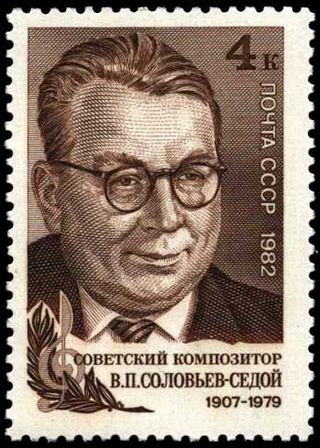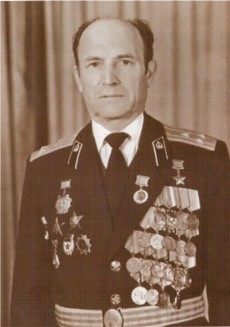Biography
Vasily Semyonovich Sukhov was born in 1925 on the Suetovo farm [lower-alpha 1] [1] into a peasant family. Russian by nationality. After finishing the 8th grade of school, he lived in Soltsy and worked with his father Semyon Fedorovich at the Pobeda state farm. [2]
On July 14, 1941, the city was occupied by the Germans; the Sukhov family did not have time to evacuate. In the summer of 1943, Vasily Sukhov, his younger brother Ivan and friend Vladimir Duplev stole a German semi-tractor and tried to use it to reach a partisan detachment. However, the Nazis organized pursuit, and the semi-tractor had to be abandoned on the outskirts of the forest. They broke away from the pursuit and soon met with the partisans of the 5th Partisan Brigade. They were enrolled in the partisan detachment. [3] Seventeen-year-old Vasily became a demolition bomber, fifteen-year-old Ivan became a scout. The brothers took part in ambushes and explosions, in the defeat of enemy garrisons, including a night raid on the German garrison in the village of Dubets near Soltsy. [3] After the liberation of the Soletsky region by the troops of the Leningrad and Volkhov fronts, [3] the 5th brigade was disbanded, and Vasily Sukhov was sent to the active army. [2]
At the beginning of June 1944, the 72nd Division advanced on the Karelian Isthmus. Komsomol organizer of the rifle company of the 14th rifle regiment V.S. Sukhov raised the soldiers to attack and broke through the enemy's defenses. For his courage he was awarded the Order of Glory, III degree.
In June 1944, in the battle for the Tali [lower-alpha 2] junction station, Red Army soldier Sukhov replaced the deceased company commander. For two days, 45 soldiers under the command of Sukhov held the station and repelled 5 enemy counterattacks. In the battle he was wounded several times, but refused to leave the company's location. Sukhov carried the seriously wounded new company commander, Senior Lieutenant Polyakov, out of the battle and was wounded in the leg by a mine fragment. Bleeding, he was sent to the 119th reception evacuation point, [3] where he died [2] on June 24, 1944 (according to other sources June 23, 1944).
He was buried in a mass grave [3] at Perk-Jarvi station. [lower-alpha 3]
By a decree of the Presidium of the Supreme Soviet of the USSR dated July 21, 1944, for the courage and heroism shown during the liberation of the Karelian Isthmus, Vasily Semenovich Sukhov was awarded the title of Hero of the Soviet Union (posthumously).

Soltsy is a town and the administrative center of Soletsky District in Novgorod Oblast, Russia, located on the left bank of the Shelon River, 78 kilometers (48 mi) southwest of Veliky Novgorod, the administrative center of the oblast. Population: 10,086 (2010 Census); 11,264 (2002 Census); 11,782 (1989 Soviet census).

Fyodor Alekseyevich Astakhov was a Soviet Marshal of Aviation.

Otomārs Aleksandrs Oškalns was a prominent Latvian communist and partisan fighter.
The Soviet partisans in Estonia were Communist partisans who attempted to wage guerrilla warfare against the German armed forces during the German occupation of Estonia. The majority of partisans sent in by the Soviets were quickly picked up by the local Estonian militias.

Piotr Filipovich Alberti was a Soviet, Russian painter, lived and worked in Leningrad, regarded as one of representatives of the Leningrad school of painting.

Vasily Pavlovich Solovyov-Sedoi was a Soviet classical composer and songwriter who was born and died in Leningrad.

Malaya Sadovaya Street is a 1979 oil painting by the Russian artist Alexander Semionov, depicting Malaya Sadovaya Street in Leningrad on rainy day of the end of the 1970s. This cityscape was painted in traditions of the Leningrad School of Painting and Soviet figurative painting of late socialist realism with their typical synthesis of realistic and impressionistic traditions to create an image of modernity.

Vasily Shalvovich Kvachantiradze was a top Soviet sniper during World War II. He is credited with confirmed kills numbering at least 215 officers and soldiers of the German Wehrmacht during the Vitebsk-Orsha Offensive and 542 confirmed kills total during the war.
The year 1991 was marked by many events that left an imprint on the history of Soviet and Russian Fine Arts. After the opening of the former Soviet Union to the world, it started to show to the world more of its arts.
The year 1985 was marked by many events that left an imprint on the history of Soviet and Russian Fine Arts.
The year 1942 was marked by many events that left an imprint on the history of Soviet and Russian fine arts.
Dmitry Vasilievich Belyaev was a Russian and Soviet painter, who lived and worked in Saint Petersburg, an Honored Artist of the Russian Federation, a member of the Leningrad Union of Soviet Artists, regarded as one of representatives of the Leningrad School of Painting.
Andrei Sergeevich Bantikov was a Russian and Soviet painter, a member of the Leningrad Union of Soviet Artists, who lived and worked in Saint Petersburg, regarded as one of representatives of the Leningrad School of Painting.
Stepan Ivanovich Privedentsev was a Soviet Russian painter, a member of the Leningrad Union of Artists, who lived and worked in Leningrad, regarded as one of representatives of the Leningrad school of painting, most famous for his genre and landscape paintings.
Oleg Arcadievich Eremeev was a Soviet Russian painter, People's Artist of the Russian Federation, a full member of the Academy of Arts of the Russian Federation (2001), a head of the Repin Institute of Arts (1990–2001), and a member of the Saint Petersburg Union of Artists, who lived and worked in Saint Petersburg. He was regarded as one of the representatives of the Leningrad school of painting, most famous for his genre and portrait paintings. He died in 2016.
Anatoli Pavlovich Levitin was a Soviet Russian painter and art educator, People's Artist of the Russian Federation, a member of the Saint Petersburg Union of Artists, who lived and worked in Saint Petersburg and Krasnoyarsk, regarded as one of representatives of the Leningrad school of painting, most famous for his genre and portrait paintings.
Ivan Ivanovich Godlevsky was a Soviet Russian painter, a member of the Saint Petersburg Union of Artists, who lived and worked in Leningrad, regarded as a representative of the Leningrad school of painting, most famous for his landscapes painted in decorative style.

Afanasy Petrovich Shilin was an artillery officer who was twice awarded the title Hero of the Soviet Union for actions in the Battle of the Dnieper and the Vistula-Oder Offensive.

Vladimir Nikolayevich Pchelintsev was a Soviet sniper during World War II. Awarded the title Hero of the Soviet Union in 1942 for killing 152 enemy soldiers, he took part in a Soviet delegation with Lyudmila Pavlichenko to the United States. In one of his memoirs he claimed to have a tally of 456 enemy soldiers killed, although most historians believe the tally is around 152 kills.

Vasily Mikhailovich Astafyev was a Soviet officer, and was a participant in the Winter War, as well as the Eastern Front. He was deputy commander of the 104th Guards Separate Sapper Battalion of the 89th Guards Rifle Division of the 37th Army of the Steppe Front, as guard captain. He received the title of Hero of the Soviet Union on 20 December 1943.









